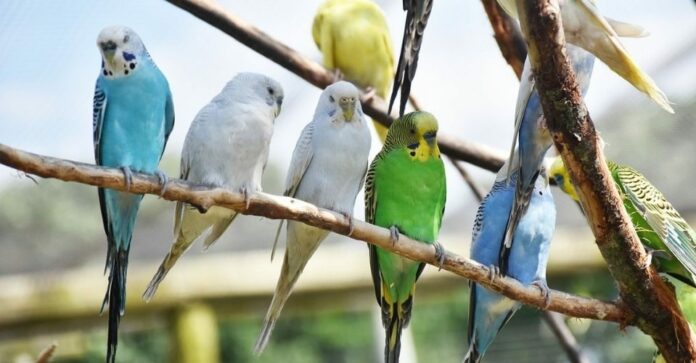How long do Parakeets live -Welcome to the wonderful world of parakeets! These colourful and charismatic birds are a delight to watch with their playful antics and charming personalities. From their chatty chirps to their acrobatic feats, parakeets are a joy to have as pets.
But how long do parakeets live, you ask? Well, that’s what we’re here to discuss! It’s a fascinating and important topic for any potential parakeet owner. After all, you don’t want to invest in a pet that won’t be with you for very long.
So, let’s dive right in! We’ll explore the various factors that can impact a parakeet’s lifespan, from genetics to diet to environment. We’ll also look at some common health issues affecting these birds and what you can do to help keep them healthy and happy.
But before we get too serious, let’s take a moment to appreciate the sheer quirkiness of parakeets. Did you know that these little birds are masters of mimicry? They can learn to imitate all sorts of sounds, from human speech to the noises of household appliances. You might even find yourself having a conversation with your feathered friend!
And speaking of conversations, parakeets are social creatures that thrive on interaction with their human companions. They love to play, explore, and learn new things. So, if you’re considering getting a parakeet, be prepared to provide plenty of stimulation and attention!
But back to the topic at hand: how long do parakeets live? That’s a tricky question. While the average lifespan of a parakeet is around 7-10 years, many factors can impact this number. So, grab a perch and settle in as we explore the ins and outs of parakeet longevity!
How long do Parakeets live in Captivity?
Parakeets are diverse birds of various sizes, colours, and species. From the small and energetic Budgerigar to the majestic and regal Indian Ringneck, parakeets are a popular choice for pet owners worldwide. We’ll take a closer look at some of the most common types of parakeets and explore how long they can live in captivity.
Here’s a list of some common types of parakeets and their average lifespan in captivity:
- Budgerigar (Budgie/Parakeet): These small and energetic birds are native to Australia and come in various colours. With proper care, they can live up to 10 years in captivity.
- Indian Ringneck Parakeet: Native to India, these birds are known for their elegant appearance and distinctive ring around their necks. They can live up to 25 years in captivity.
- Alexandrine Parakeet: These colourful birds are native to India and can live up to 25 years in captivity with proper care.
- Quaker Parakeet (Monk Parakeet): These social birds are native to South America and come in various colours. They can live up to 20 years in captivity.
- Sun Conure: With their vibrant orange and yellow plumage, Sun Conures are hard to miss. They are native to South America and can live up to 25 years in captivity.
- Green Cheek Conure: These small and playful birds are native to South America and come in various colours. They can live up to 15 years in captivity.
- Pacific Parrotlet: These tiny parrots are native to South America and come in various colours. They can live up to 20 years in captivity with proper care.
- Lineolated Parakeet (Barred Parakeet): These small and quiet birds are native to Central and South America and come in various colours. They can live up to 10 years in captivity.
Parakeets in Wildlife VS. Parakeets in Captivity
Parakeets are a group of birds that can be found in the wild and in captivity. While both wild and captive parakeets share some similarities, there are also significant differences that can impact their lifespan.
Parakeets live in various habitats in the wild, ranging from dense forests to open grasslands. They are agile and intelligent birds that can navigate their surroundings to find food and water. Wild parakeets have the benefit of being able to fly freely, which helps keep them physically fit and mentally stimulated. However, they also face predators, disease, and resource competition. Some species are also impacted by habitat loss and other environmental factors that can affect their lifespan.
Parakeets are often kept as pets in captivity and provided with a comfortable living environment. They have access to food, water, and medical care, which can help them stay healthy and live longer lives. However, captivity can also present its own set of challenges that can impact their lifespan.
Factors that affect the lifespan of parakeets in the wild include:
- Habitat loss and destruction
- Predation by other animals
- Competition for resources such as food and water
- Exposure to disease and environmental toxins
Factors that affect the lifespan of parakeets in captivity include:
- Diet – A poor diet lacking in essential nutrients can lead to health problems and a shorter lifespan.
- Exercise – Parakeets need regular exercise to maintain their physical and mental health.
- Environment – Parakeets need a clean and comfortable living environment that meets their needs.
- Medical care – Regular and veterinary check-ups are necessary to prevent and treat health problems.
- Stress – Parakeets are social birds that need companionship and stimulation to prevent stress and boredom.
Stages in the life of a Parakeet
Parakeets go through various life stages, like most living organisms, with specific physical and behavioural changes. Understanding the age stages in parakeets can help pet owners provide appropriate care and attention to their feathered friends throughout their lifespan.
- Juvenile: The juvenile stage in parakeets typically lasts from hatching to about six months of age. During this stage, parakeets depend on their parents for food and care. They also learn necessary social and behavioural skills to help them survive and thrive in the wild.
- Young adult: The young adult stage in parakeets usually lasts from six months to two years of age. During this stage, parakeets become independent and develop their own personalities. They may also go through their first moult, where they shed their feathers and grow new ones.
- Middle age: The median age stage in parakeets typically lasts from two to six years. During this stage, parakeets are in their prime and are at their most active and social. They may also have their final moult, where their adult feathers come in.
- Senior: The senior stage in parakeets usually starts around six years of age and lasts until the end of their lifespan. During this stage, parakeets may become less active and develop age-related health issues. However, they can still enjoy a good quality of life with proper care.
- Death: Like all living organisms, parakeets eventually pass away. The lifespan of a parakeet can vary depending on genetics, diet, environment, and overall health. Pet owners must be prepared for this eventuality and provide their parakeets with a comfortable and caring environment throughout their lifespan.
What are the Signs of a healthy Parakeet?
A healthy parakeet is active, alert, and has a shiny and smooth coat of feathers. Here are some signs of a healthy parakeet:
- Active behaviour: A healthy parakeet is dynamic and moves around its cage, flaps its wings and interacts with its environment.
- Alertness: A healthy parakeet is alert and aware of its surroundings. It responds to sounds and movements and has bright, clear eyes.
- Smooth and shiny feathers: A healthy parakeet has a smooth and glossy coat of feathers. The feathers should be clean and well-groomed.
- Good appetite: A healthy parakeet has a good appetite and eagerly eats various foods. It also drinks plenty of water.
- Clean beak and feet: A healthy parakeet has a clean beak and feet, free from any signs of discharge or buildup.
What to do when your Parakeet gets sick?
If your parakeet gets sick, acting quickly to provide the necessary care and treatment is essential. Here are some steps you can take to help your ill parakeet:
- Observe their behaviour: The first step in caring for a sick parakeet is to observe its behaviour. Look for changes in appetite, energy level, and behaviour. Sick parakeets may be lethargic, have trouble breathing, or show other signs of illness.
- Separate from other birds: If you have other birds, it’s essential to separate your sick parakeet from them to prevent the spread of illness. Place your sick parakeet in a separate cage and clean any shared spaces or items to prevent the spread of illness.
- Keep them warm and comfortable: Sick parakeets may need extra warmth to help them recover. Keep them in a warm, draft-free area and provide a heating pad or lamp if necessary. Make sure they have a comfortable and quiet space to rest.
- Provide fresh water and food: Sick parakeets may have trouble eating or drinking, so it’s essential to offer them fresh water and food regularly. Offer them a variety of healthy foods and consider offering them soft or mashed foods to make eating easier.
- Seek veterinary care: If your parakeet’s symptoms persist or worsen, it’s essential to seek veterinary care as soon as possible. A veterinarian can diagnose and treat your parakeet’s illness and advise how to care for them during recovery.
Wrapping Up
Parakeets are fascinating creatures that can bring joy and companionship to their owners for many years. While several factors affect their lifespan, parakeets can live long with proper care and attention. So, if you’re considering getting a parakeet, commit to caring for them for many years. And with some luck, you may even end up with the next world record holder for the oldest living parakeet!
Frequently Asked Questions (FAQs):
- How long do parakeets live?
Parakeets can live for 7-10 years in the wild and up to 15-20 years in captivity. - What should I feed my parakeet?
Parakeets need a varied diet that includes seeds, pellets, fresh fruits and vegetables, and occasional treats. - Can parakeets be kept alone?
While parakeets are social birds and enjoy the company of other birds, they can also be kept alone as long as they receive enough attention and stimulation from their human caretakers. - How often should I clean my parakeet’s cage?Parakeet cages should be cleaned at least once weekly, with daily spot cleaning of soiled areas.
- What is the oldest parakeet in history?
The oldest known parakeet was Charlie, a budgerigar who lived to be 29 years and 8 months old.

















